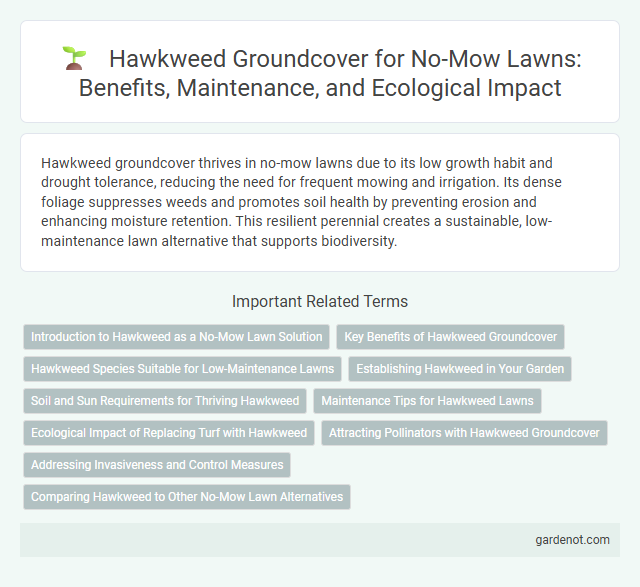Hawkweed groundcover thrives in no-mow lawns due to its low growth habit and drought tolerance, reducing the need for frequent mowing and irrigation. Its dense foliage suppresses weeds and promotes soil health by preventing erosion and enhancing moisture retention. This resilient perennial creates a sustainable, low-maintenance lawn alternative that supports biodiversity.
Introduction to Hawkweed as a No-Mow Lawn Solution
Hawkweed, a hardy groundcover native to temperate regions, offers an eco-friendly no-mow lawn alternative with its low-growing habit and vibrant yellow flowers. Tolerant of poor soils and drought conditions, hawkweed establishes quickly, reducing maintenance and water usage compared to traditional grass lawns. Its dense mat inhibits weed growth, promoting a sustainable and visually appealing green space year-round.
Key Benefits of Hawkweed Groundcover
Hawkweed groundcover promotes soil erosion prevention and enhances water retention, making it an eco-friendly choice for no-mow lawns. Its low maintenance requirements reduce the need for watering and mowing, supporting sustainable landscaping practices. Hawkweed's dense growth suppresses weed proliferation, contributing to a healthier, more resilient lawn ecosystem.
Hawkweed Species Suitable for Low-Maintenance Lawns
Hawkweed species such as Hieracium venosum and Hieracium pilosella are ideal for no-mow lawns due to their drought tolerance and ground-hugging growth habits. These low-maintenance plants thrive in well-drained soils and require minimal watering, making them perfect for sustainable lawn alternatives. Their dense foliage suppresses weeds and reduces the need for frequent mowing, promoting an eco-friendly, resilient lawn.
Establishing Hawkweed in Your Garden
Establishing hawkweed as a no-mow groundcover requires well-drained soil and full sun to partial shade for optimal growth. Begin by sowing hawkweed seeds in early spring or early fall to ensure strong root development before extreme temperatures. Regularly monitor moisture levels and avoid overwatering to prevent root rot, promoting a dense, low-maintenance lawn alternative.
Soil and Sun Requirements for Thriving Hawkweed
Hawkweed groundcover thrives best in well-drained, moderately fertile soil with a neutral to slightly acidic pH, ideally between 6.0 and 7.0. It requires full sun to partial shade, with at least 4 to 6 hours of direct sunlight daily to promote vigorous growth and dense coverage. Proper soil aeration and adequate moisture retention enhance root development and overall plant health for sustainable, low-maintenance no-mow lawns.
Maintenance Tips for Hawkweed Lawns
Hawkweed lawns require minimal maintenance, thriving with occasional watering and natural rainfall to sustain their drought tolerance. Regularly mowing at a high setting prevents flowering and encourages dense, low-growing foliage that suppresses weeds. Applying organic mulch around the edges helps retain soil moisture and reduces weed competition, promoting a lush, eco-friendly no-mow lawn.
Ecological Impact of Replacing Turf with Hawkweed
Replacing traditional turf with Hawkweed groundcover enhances biodiversity by providing essential habitat and nectar for pollinators such as bees and butterflies. Its deep root systems improve soil health and water retention, reducing erosion and the need for synthetic fertilizers or irrigation. This low-maintenance, drought-tolerant plant contributes to carbon sequestration, making it an eco-friendly alternative to conventional lawns.
Attracting Pollinators with Hawkweed Groundcover
Hawkweed groundcover creates a vibrant habitat that attracts a diverse range of pollinators including bees, butterflies, and hoverflies essential for ecosystem health. Its bright yellow flowers bloom continuously throughout the growing season, providing a reliable nectar source that supports pollinator populations. Cultivating Hawkweed in no-mow lawns enhances biodiversity and ensures pollinator activity critical for garden and wild plant reproduction.
Addressing Invasiveness and Control Measures
Hawkweed groundcover, often considered invasive in no-mow lawns, spreads rapidly through stolons and seeds, outcompeting native plants and reducing biodiversity. Effective control measures include manual removal before seed set, application of targeted herbicides, and promoting dense, healthy turfgrass to resist hawkweed establishment. Regular monitoring and timely intervention are critical to prevent hawkweed from dominating the lawn ecosystem.
Comparing Hawkweed to Other No-Mow Lawn Alternatives
Hawkweed groundcover offers a resilient and low-maintenance alternative to traditional no-mow lawn options such as clover and moss. Its deep root system enhances soil stability and drought tolerance, outperforming shallow-rooted species in sandy or compacted soils. Unlike other groundcovers, Hawkweed requires minimal watering and provides consistent green coverage throughout the growing season, making it an efficient choice for sustainable landscaping.
Hawkweed groundcover Infographic

 gardenot.com
gardenot.com